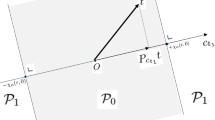Abstract
The Choquet expected utility model deals with nonadditive probabilities (or capacities). Their dependence on the information the decision-maker has about the possibility of the events is taken into account. Two kinds of information are examined: interval information (for instance, the percentage of white balls in an urn is between 60% and 100%) and comparative information (for instance, the information that there are more white balls than black ones). Some implications are shown with regard to the core of the capacity and to two additive measures which can be derived from capacities: the Shapley value and the nucleolus. Interval information bounds prove to be satisfied by all probabilities in the core, but they are not necessarily satisfied by the nucleolus (when the core is empty) and the Shapley value. We must introduce the constrained nucleolus in order for these bounds to be satisfied, while the Shapley value does not seem to be adjustable. On the contrary, comparative information inequalities prove to be not necessarily satisfied by all probabilities in the core and we must introduce the constrained core in order for these inequalities be satisfied. However, both the nucleolus and the Shapley value satisfy the comparative information inequalities, and the Shapley value does it more strictly than the nucleolus.
Similar content being viewed by others
REFERENCES
Montesano, A. (1994), Non-additive probabilities and the measure of uncertainty and risk aversion: A proposal. In: B. Munier and M.J. Machina (eds.), Models and Experiments in Risk and Rationality (pp. 59-74). Dordrecht/Boston/London: Kluwer Academic Publishers.
Montesano, A. and Giovannoni, F. (1996), Uncertainty aversion and aversion to increasing uncertainty, Theory and Decision 41, 133-148.
Montesano, A. (1999), Risk and uncertainty aversion with reference to the theories of expected utility, rank dependent expected utility, and Choquet expected utility. In: L. Luini (ed.), Uncertain Decisions, Bridging Theory and Experiments (pp. 3-37). Dordrecht/Boston/London: Kluwer Academic Publishers.
Schmeidler, D. (1969), The nucleolus of a characteristic function game, SIAM Journal of Applied Mathematics 17, 1163-1170.
Schmeidler, D. (1989), Subjective probability and expected utility without additivity, Econometrica 57, 571-587.
Shapley, L.S. (1971), Cores of convex games, International Journal of Game Theory 1, 11-26.
Shubik, M. (1981), Game theory models and methods in political economy. In: K.J. Arrow and M.D. Intriligator (eds.), Handbook ofMathematical Economics, Vol. I (pp. 285-330). Amsterdam: North-Holland.
Author information
Authors and Affiliations
Corresponding author
Rights and permissions
About this article
Cite this article
Montesano, A. Uncertainty with Partial Information on the Possibility of the Events. Theory and Decision 51, 183–195 (2001). https://doi.org/10.1023/A:1015503010031
Issue Date:
DOI: https://doi.org/10.1023/A:1015503010031




